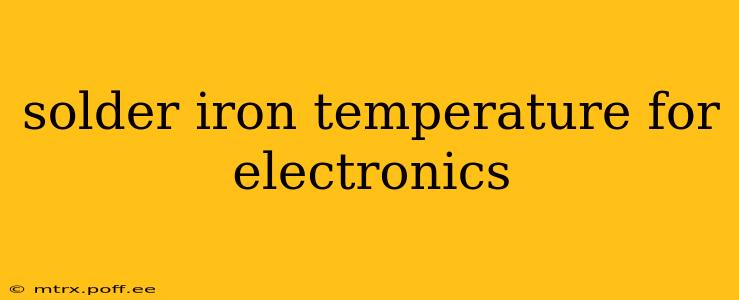Soldering is a fundamental skill for anyone working with electronics, whether it's a hobbyist repairing a broken gadget or a professional building complex circuits. But achieving a perfect solder joint relies heavily on using the correct solder iron temperature. Too hot, and you risk damaging components; too cold, and you'll end up with a weak, unreliable connection. This guide will delve into the optimal temperatures for various soldering tasks, helping you achieve consistently high-quality results.
What is the ideal solder iron temperature for electronics?
There's no single magic number for the ideal solder iron temperature. The best temperature depends on several factors, including:
- Type of solder: Lead-free solder generally requires higher temperatures than leaded solder. Leaded solder typically melts around 183°C (361°F), while lead-free solder often needs temperatures between 217°C (423°F) and 232°C (450°F).
- Solder tip size: Smaller tips require less heat to reach the necessary temperature, while larger tips need a higher setting.
- Component size and type: Delicate surface-mount components require lower temperatures and more precise heat application than larger through-hole components.
- Ambient temperature: In cooler environments, you might need a slightly higher temperature setting.
A good starting point for most electronics work is 350°C (662°F). However, this is a guideline. You might need to adjust this temperature up or down depending on the specific situation. Experimentation is key to finding the sweet spot for your setup and components.
What happens if the solder iron temperature is too high?
Using a solder iron that is too hot can lead to several problems:
- Component damage: Excessive heat can damage sensitive components, potentially destroying them entirely. This is especially true for integrated circuits (ICs) and other surface-mount devices (SMDs).
- Solder bridging: The molten solder can spread too quickly, creating unwanted bridges between components.
- Burnt components: High temperatures can burn or char circuit boards and components, leading to malfunctions.
- Tip degradation: Overheating the tip can shorten its lifespan.
What happens if the solder iron temperature is too low?
A solder iron that is too cool will also result in poor solder joints:
- Cold joints: The solder won't melt properly, resulting in weak, unreliable connections that are prone to failure. These are often characterized by a dull, grayish appearance.
- Poor wetting: The solder won't adequately flow and adhere to the component leads and the PCB pad.
- Difficulty in soldering: It will be more difficult to achieve a smooth, even solder joint.
How to choose the right solder iron temperature for different components?
The temperature required varies based on component type:
- Through-hole components: These generally tolerate higher temperatures. A range of 350-400°C (662-752°F) usually works well.
- Surface-mount components (SMDs): These are far more sensitive to heat. Lower temperatures, typically in the 300-350°C (572-662°F) range, are essential to avoid damage. Consider using a smaller tip for better heat control.
- Fine-pitch components: These require even more precision and lower temperatures. Start at 300°C (572°F) and adjust as needed.
How do I check the temperature of my solder iron?
Many modern solder stations have digital displays that show the actual temperature. However, if your iron lacks this feature, you can use an infrared thermometer to check the tip temperature. Always measure the temperature of the tip itself, not the setting on the iron's dial, as there can be significant discrepancies.
What type of solder is best for electronics?
The choice between leaded and lead-free solder depends on various factors including local regulations and personal preference. Leaded solder is often easier to work with due to its lower melting point and better flow characteristics. However, environmental concerns have led to the increasing prevalence of lead-free solder.
How can I improve my soldering technique for better results?
Beyond temperature control, excellent soldering technique includes using the correct amount of solder, proper flux application, and employing the right soldering method for the specific components and situation. Practice is crucial to refine your skills.
By understanding the ideal solder iron temperature and applying the right techniques, you can achieve high-quality, reliable solder joints, ensuring the longevity and performance of your electronic projects. Remember, patience and practice are key to mastering this essential skill.
